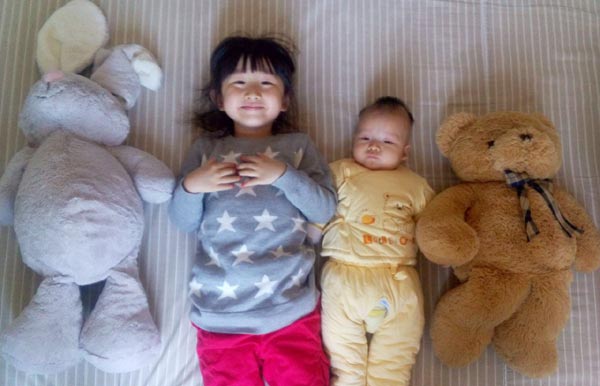 |
|
Li Shuchun, 4, and his 7-month-old brother Li Shuhan, live in Beijing with their parents who are among the 1.07 million out of 11 million eligible couples applied to have a second child by the end of last year. [Photo by Wang Nina/Provided to chinadaily.com.cn] |
A two-child policy allowing all couples in China to have a second child has been submitted to the nation's decision-makers as part of a report on China's future population development strategy.
An unnamed source told China Business News that the report was submitted at the request of the decision-makers, which is a signal that China's family planning policy might see a major change in the near future.
The policy would help with the country's demographic problems, such as rapid aging and low birth rate.
Population has much to do with production, consumption and employment in a country, so population policy attracts wide attention in China, the world's most-populous country.
China introduced the family planning policy as a basic state policy in 1983 to control population size and improve people's heath.
But the increasingly growing aging population poses difficulties for youngsters to support their elderly parents, especially when some couples have to support four elderly people.
In 2014, the number of Chinese aged 65 and older was 137 million, accounting for 10.1 percent of the whole population. In demographic terms, 7 percent of total population in this age group means an aging society.
China will have the largest aging population in 2050 when 35 percent of the country's population will be more than 60 years old in 2015, as estimated by the World Health Organization.
The family planning policy was adjusted in 2013 to allow couples to have a second child when one spouse is an only child.
Besides the looming aging society, China has also experienced a low birth rate, a problem in the population structure, which may cause the country a lack of fresh troops in production and consumption.
The percentage of the population aged under 14 in China declined from 33.6 in 1982 to 16.6 in 2010, according to the National Bureau of Statistics; any society with a population in that age bracket between 15 and 18 percent of the total populace faces a severely low birth rate.
A declining working-age population for consecutive three years directly caused labor shortages in China, which threatens sound economic development, let alone an aging phenomenon happening in the working force.
"These problems overlap and would pose huge challenges in 2020, so it's urgent to carry out an overall two-child policy, which will be the most direct and desirable solution, though it cannot solve the problems fundamentally," said Yao Meixiong, a demographer at the Fujian Provincial Bureau of Statistics.
Birth rate is especially needed to lift up, since youth are the main force of production, consumption and innovation, which are all beneficial for a country's development.
"People can enjoy the population dividend in the early years when the birth rate is low, but will suffer the consequences later", said Huang Wenzheng, a demographer with the Humanism Economics Society.
